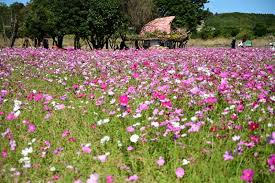**Cosmos Flowers: Their Role in Sustainable and Green Economic Development**

Cosmos flowers, with their vibrant colors and ecological benefits, play a crucial role in promoting sustainable and green economic development initiatives around the world. As symbols of environmental stewardship and biodiversity, cosmos flowers contribute to various sectors of the economy, including agriculture, tourism, and eco-friendly industries. In this comprehensive exploration, we delve into the multifaceted role of cosmos flowers in fostering green and sustainable economic growth, highlighting their potential to create jobs, generate income, and promote environmental conservation.
**1. Sustainable Agriculture and Agroecology:**
Cosmos flowers are integrated into sustainable agriculture practices and agroecological systems that prioritize environmental conservation, soil health, and biodiversity. By incorporating cosmos plantings into crop rotations, cover cropping, and agroforestry systems, farmers can enhance soil fertility, suppress weeds, and attract beneficial insects, thus reducing the need for synthetic inputs and promoting ecological balance. Sustainable agriculture initiatives featuring cosmos flowers support small-scale farmers, improve food security, and mitigate the adverse effects of conventional farming practices on the environment.
**2. Ecotourism and Nature-Based Recreation:**
Cosmos flowers contribute to the development of ecotourism and nature-based recreation activities that showcase the natural beauty and biodiversity of landscapes where they thrive. Ecotourism destinations featuring cosmos fields, botanical gardens, and nature reserves attract visitors seeking immersive experiences in pristine natural environments. Guided tours, wildlife watching, and eco-adventure activities centered around cosmos flowers provide opportunities for sustainable tourism development, job creation, and economic diversification in rural communities.
**3. Green Infrastructure and Urban Planning:**
Cosmos flowers are incorporated into green infrastructure and urban planning projects aimed at enhancing the sustainability and resilience of cities and urban environments. Green roofs, rain gardens, and urban parks featuring cosmos plantings provide multiple benefits, including stormwater management, heat island mitigation, and biodiversity conservation. By integrating cosmos flowers into urban landscapes, cities can create healthier, more livable environments that promote human well-being, reduce energy consumption, and support local economies.
**4. Sustainable Forestry and Land Management:**
Cosmos flowers play a role in sustainable forestry and land management practices that prioritize ecosystem health, carbon sequestration, and habitat conservation. Agroforestry systems incorporating cosmos plantings alongside timber and fruit trees enhance biodiversity, improve soil structure, and provide additional sources of income for landowners. Sustainable forestry initiatives featuring cosmos flowers contribute to climate change mitigation, watershed protection, and the restoration of degraded landscapes, thus promoting long-term economic and environmental sustainability.
**5. Green Technologies and Eco-Industries:**
Cosmos flowers inspire the development of green technologies and eco-industries that harness the renewable resources and ecological services provided by nature. Bio-based products derived from cosmos flowers, such as natural dyes, essential oils, and herbal extracts, are used in cosmetics, pharmaceuticals, and sustainable fashion industries. Green technologies, such as phytoremediation and bioenergy production, leverage the unique properties of cosmos flowers to address environmental challenges and promote eco-friendly solutions for waste management and renewable energy production.
**6. Sustainable Tourism and Cultural Heritage:**
Cosmos flowers contribute to sustainable tourism and cultural heritage preservation initiatives that celebrate the natural beauty and cultural significance of landscapes where they grow. Cultural festivals, eco-trails, and agritourism experiences featuring cosmos flowers showcase local traditions, folklore, and indigenous knowledge associated with these iconic blooms. Sustainable tourism activities centered around cosmos flowers provide opportunities for local communities to share their cultural heritage, generate income from tourism, and protect natural resources for future generations.
**7. Green Business and Corporate Sustainability:**
Cosmos flowers inspire green business practices and corporate sustainability initiatives that prioritize environmental responsibility, social equity, and economic prosperity. Businesses and corporations incorporate cosmos flowers into their sustainability strategies through green procurement, carbon offset programs, and biodiversity conservation initiatives. By investing in green technologies, eco-friendly products, and nature-based solutions featuring cosmos flowers, companies can reduce their environmental footprint, enhance their brand reputation, and contribute to the transition to a more sustainable and resilient economy.
**8. Conclusion:**
In conclusion, cosmos flowers play a vital role in advancing sustainable and green economic development initiatives that promote environmental conservation, social equity, and economic prosperity. From sustainable agriculture and ecotourism to green infrastructure and eco-industries, cosmos flowers offer diverse opportunities for fostering green growth, creating jobs, and building resilient communities. By harnessing the economic potential and ecological benefits of cosmos flowers, we can transition towards a more sustainable and inclusive economy that benefits people and the planet for generations to come.